Volcano Live
volcanolive.com
Arenal Volcano | John Seach

Costa Rica
10.463 N, 84.703 W
summit elevation 1720 m
Stratovolcano
Arenal is the youngest stratovolcano in Costa Rica and was one of its most active between 1968 and 2010. Arenal’s crater contains a lava pool, which is composed of viscous basaltic andesite. During its eruptions lava extruded in a pulsating pattern, forming a crust, and then overflowed the crater rim and flowed almost continuously down the north to southwest flanks of the volcano.
Arenal volcano has become dormnant
Arenal volcano has not erupted since 2010. This is the first period of dormancy since 1968. The last dormant period lasted 500 years.
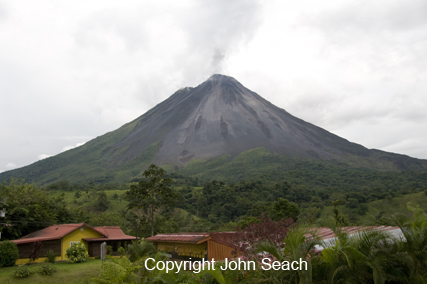
Arenal volcano
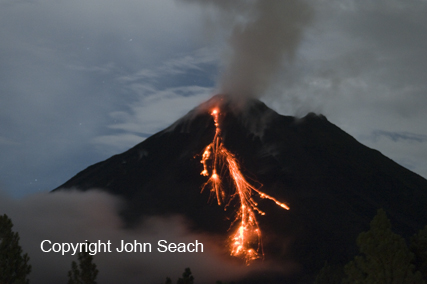
Arenal volcano 2010
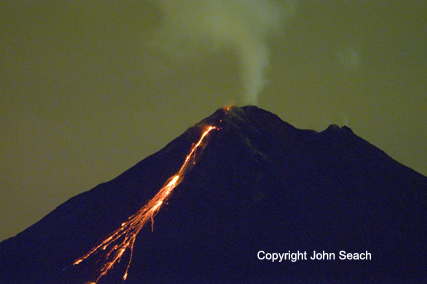
Arenal volcano in June 2010, a few weeks before it became dormant
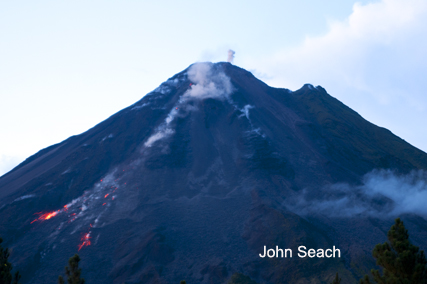
Arenal eruption 2010
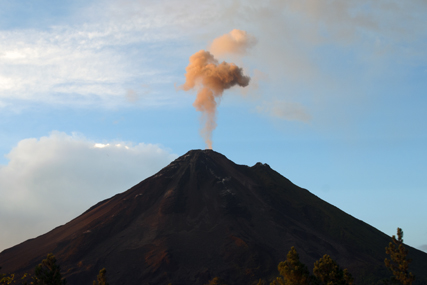
Arenal June 2010
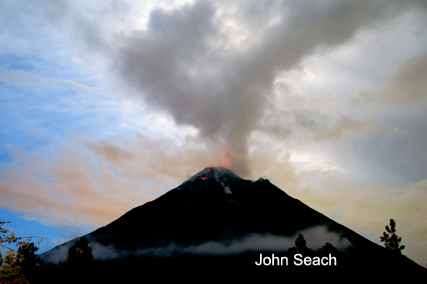
Arenal June 2010
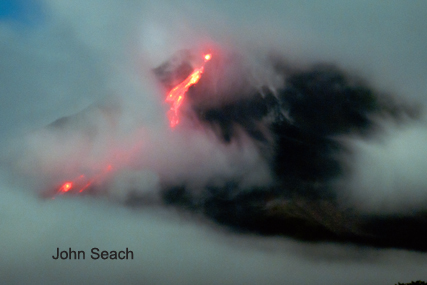
Arenal eruption June 2010
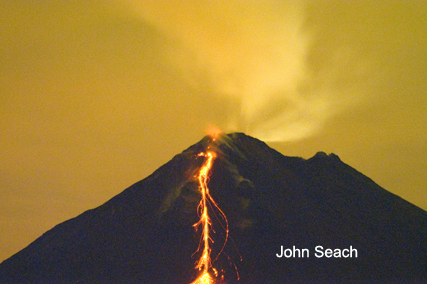
Arenal eruption 2010
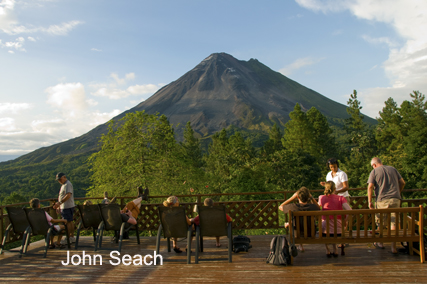
Arenal volcano from Observatory Lodge

Arenal volcano
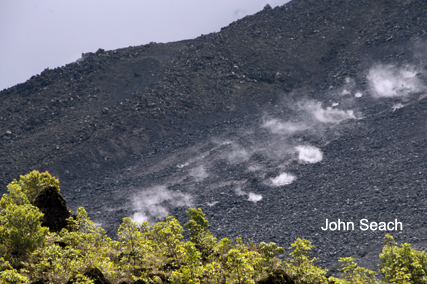
Lava avalanche, Arenal volcano, 2010
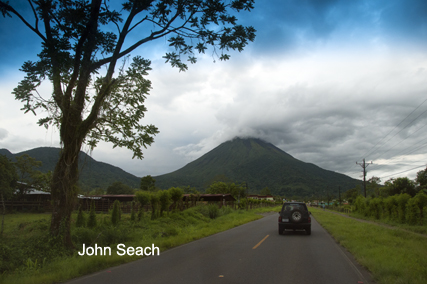
Arenal
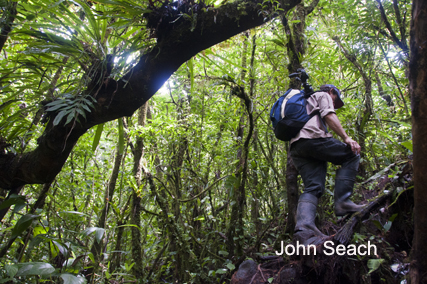
Climbing Arenal volcano 2010
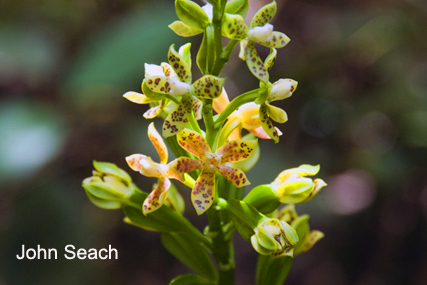
Orchid growing on Arenal volcano
Volcanic activity since 1968 has included explosive activity, strombolian eruptions, slow blocky lava flows, lava avalanches, pyroclastic flows, and hyper-concentrated stream-flows. These present a hazard to tourists and locals near the volcano.
Stage 1 eruptions from 1968–1971 were from a closed system.
Stage 2 eruptions from 1971–current were produced from an open system.
Pyroclastic flows are common at Arenal volcano. Pyroclastic flows since 1986 have been associated with moderate column collapse from Strombolian explosions, and small block avalanches from active lava fronts.
2010 Eruptions
Eruptions continue at Arenal volcano in 2010. During February eruptions occurred at crater C with gas emission, strombolian eruptions, and avalanches. A lava flow extended down the SW flank. There was only fumarolic activity at crater D.
2009 Eruptions
During 2009 activity at Arenal volcano consisted of Strombolian eruptions, avalanches, and lava flows. In mid June the hazard level was raised to Level 3 (on an increasing scale of 1-4), due to increased gas emission. On 16th June, pyroclastic flows resulted in the temporary closure of the National Park to visitors for one day.
2008 Eruptions
Eruptions at Arenal volcano in January 2008 consisted of Strombolian explosions, avalanches, and lava flows. Blocks from the lava flow occasionally set fire to vegetation. On 6th June, a debris avalanche extended 800 m down the SW flank of Arenal. Tourists and park rangers 2 km away on the western side of the volcano were evacuated. An avalanche on 10th June produced an ash plume, and resulted in evacuations near the volcano.
2007 Eruptions
Arenal volcano continued to be active in 2007 with Strombolian eruptions, lava flows and avalanches. On 18th September 2007 multiple pyroclastic flows travelled 1km south of the volcano.
2006 Eruptions
Activity at Arenal volcano during 2006 consisted of gas emissions, Strombolian eruptions, lava flows extending north, and avalanches from lava-flow fronts.
2005 Eruptions
Explosions began at Arenal volcano on 2nd November 2005. A pyroclastic flow was generated at 1502 hr and extended 1 km down the west flank.
2004 Eruptions
An eruption at Arenal volcano on the 6th July 2005 sent lava avalanches down the volcano's flanks.
2003 Eruptions
Arenal's eruptions in 2003 consisted of lava flows down the west, north, and northeast. On the 5th September 2003 there was a pyroclastic flow. Lava flows descended to 800 m down the volcano's north and northeast flanks.
2000 Eruptions and Fatalities
Activity increased at Arenal volcano during the second half of April 2000. A series of explosions occurred at Arenal on 23rd August 2000. At 1336 hr a ten-minute long pyroclastic flow occurred. A Costa Rican tour guide and two tourists were overrun by a pyroclastic flow on 23rd August. The tour guide and an 8 year old girl died in hospital from burns suffered in the eruption. The pyroclastic flow extended 2.3 km from the crater and reached a maximum velocity of 80 km/hr. The eruptions on 23rd August 2000 were the strongest at Arenal volcano since 1968. On 26th August 2000 a passenger plane crashed 200 m below the summit of Arenal volcano, killing all ten people on board. The plane was flying from Fortuna to Tamarindo. The plane had deviated from its normal route along the coast, possibly to view eruptive activity.
1999 Eruptions
Eruptions decreased at Arenal volcano in April 1999.
1998 Eruptions
Strong eruptions occurred at Arenal volcano on 5th May 1998, with 23 pyroclastic flows. The pyroclastic flows reached a maximum distance of 2 km from the summit and travelled at 60 km/hr. On 12th May a lava flow descended northwest to an elevation of 780m.
1993 Eruption
During the night of 28 August 1993 a previously unknown type of pyroclastic
flow, generated during a partial cone collapse and outpouring of an active lava pool at Arenal. This type of event has subsequently been identified at Arenal in June 1975, May 1998, August 2000, March 2001, at Cotopaxi (Ecuador) in 1877, and at Asama (Japan) in 1783. This phenomenon has important volcanic hazard implications for tourist development on the flanks of the volcano.
1988 Eruptions and Fatality
A tourist was killed by ballistics while standing in the danger zone near Arenal's crater on 6th July 1988.
1968 Eruption
Cows were seen by farmers moving down from the middle upper slopes of the volcano 2 weeks prior to the eruption. A major explosive eruption occurred at Arenal volcano between July 29–31, 1968, after centuries of dormancy. The first explosions occurred at 0730 hr on 29th July. The eruption produced three new craters. The lateral explosion resulted in 70 deaths and damage to former Pueblo Nuevo and Tabacón villages from hot gases, tephra, and ballistic blocks. A major explosion occurred at 1310 hr on 31st July 1969, and produced a hot ash-cloud surge, which overwhelmed two rescuing cars near the Tabacón river, killing 8 people.
The largest explosion crater was 260 m across and was located at an elevation of 1060m. Most of the devastating explosions from July 29-31 occurred at this crater. Many houses at Pueblo Nuevo village were partially or totally destroyed by bomb impacts and ash fall on roofs causing collapse. Some wooden houses at Pueblo
Nuevo were charred by the tephra, which indicated a
temperature of fine ejecta and air between 300 and 500 deg C.
The explosions on 29th July 1968 devastated an area of 13.3 sq km, and 3 sq km on 31 July. Ash affected 230 sq km, and was deposited over an area of 1580 sq km.
1951-65 Unrest
An increase in restlessness occurred at Arenal volcano beginning 1951. This included emissions on the NE flank of the volcano, decrease in water level of Cedeño lake
on the north flank, causing fish death, fumaroles at the summit crater increased in number: 15 fumaroles in 1951 and 30 fumaroles in 1959.
Further reading
Bolge, L.L., Carr, M.J., Feigenson, M.D. and Alvarado, G.E., 2006. Geochemical stratigraphy and magmatic evolution at Arenal volcano, Costa Rica. Journal of Volcanology and Geothermal Research, 157(1-3), pp.34-48.
Melson, W.G. and Saenz, R., 1973. Volume, energy and cyclicity of eruptions of Arenal Volcano, Costa Rica. Bulletin Volcanologique, 37(3), pp.416-437.
Alvarado, G.E., Soto, G.J., Schmincke, H.U., Bolge, L.L. and Sumita, M., 2006. The 1968 andesitic lateral blast eruption at Arenal volcano, Costa Rica. Journal of Volcanology and Geothermal Research, 157(1-3), pp.9-33.
Arenal Volcano Eruptions
1968-2010, 1750 ± 50, 1440?, 1400?, 1030?, 1020?, 750 AD ± 50, 700 AD?, 650 AD ± 100, 550 AD?, 400 AD?, 170 BC ± 200, 270 BC?, 380 BC ± 200, 830 BC ± 500, 1250 BC ± 200, 1450 BC?, 1650 BC?, 1770 BC ± 100, 2250 BC?, 2800 BC?, 3190 BC ± 100, 3350 BC?, 3900 BC?, 4450 BC?, 5060 BC ± 150